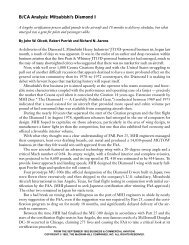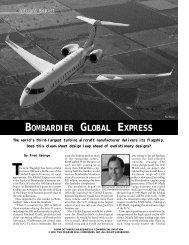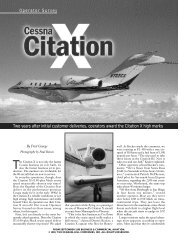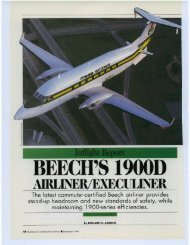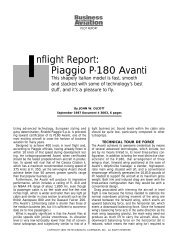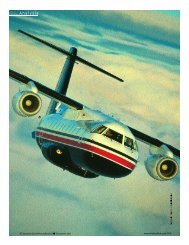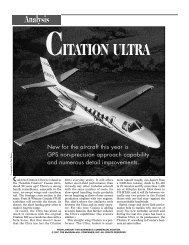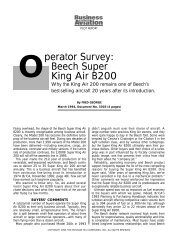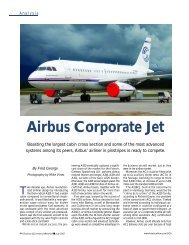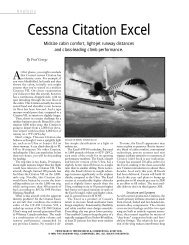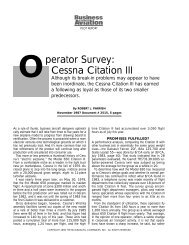B/CA Analysis: Cessna Citation V
B/CA Analysis: Cessna Citation V
B/CA Analysis: Cessna Citation V
- No tags were found...
You also want an ePaper? Increase the reach of your titles
YUMPU automatically turns print PDFs into web optimized ePapers that Google loves.
P ilotReportThe <strong>Citation</strong> V’s horizontal stabilizer and full-span elevatorsections measure 21.5 feet, tip-to-tip, comparedwith the 19-foot span of the <strong>Citation</strong> II tail.The area of the <strong>Citation</strong> V’s horizontal tail is 84.8square feet compared with 69.8 square feet for the<strong>Citation</strong> II and S/II. The aspect ratio of the new tail is5.43 compared to 5.96.Of course, there’s a lot more beef in the vertical stabilizerand in the empennage itself to handle higher rotationand inflight loads.INCREASED POWER AND RELIABILITYThe final major element in <strong>Citation</strong> V evolution is representedby its powerplants. <strong>Cessna</strong> listens to its owners,and the item at the top of every <strong>Citation</strong> owner’s wishlist always has been “more power.” More power wouldhelp with the rest of the wish list items that usuallyinclude “higher, faster cruise at heavier weights.” Thusthe change to the latest in P&W small-engine technology-theJT15D-5A.The -5A engine develops 2,900 pounds static thrustcompared to 2,500 pounds for the -4 engine used onthe <strong>Citation</strong> II. The -5A has a new, high-efficiencyexhaust nozzle and its bypass ratio is reduced to 2.1-to-1 compared with 2.5-to-1 for the -4. The reduction inbypass ratio improves altitude performance.<strong>Cessna</strong> elected to outfit the -5A engines in this installationwith hydromechanical fuel controllers rather thanthe electronic fuel controllers mounted on -5s that powerthe T-47 <strong>Citation</strong> derivative. Mechanical fuel controllersimprove dispatch reliability, while electronic fuel controllersreduce cockpit workload. <strong>Cessna</strong> believes thatcorporate operators will gladly put up with power monitoringchores to avoid some of the maintenance hasslesinherent to electronic fuel controllers. On the otherhand, the U.S. Navy’s training mission can be prettyrough on engines, and the military seems willing totrade dispatch reliability for insurance against engineovertemps and overtorques committed by ham-handedstudents. Target-type, hydraulically actuated thrustreversers are standard.MORE MEANS MOREDevelopment of the Model 560 gave the Wichita companya chance to make several other substantialimprovements. The TKS leading edge anti-ice systemthat was introduced on the S/II is gone (few tears willbe shed). The messy, heavy TKS has been replaced bylow-profile inflatable boots on the outboard panels andby bleed-air-heated leading edges on the inboard sectionsforward of the engine intakes. Nose and tail baggage-doorlocks and the door-ajar warning circuitryhave been changed to improve door security and toreduce false warnings.Interior changes begin in the cockpit with standardtwo-tube, Honeywell EFIS on the left side and a Global-WulfsbergGNS-X nav management system (completewith Loran-C sensor) in the console between thepilots’ seats.Improvements in the passenger cabin are impressive,too. The 20 inches of fuselage stretch belongs to thesame seven-to-nine passenger seats that occupied theshorter-fuselage <strong>Citation</strong>s. In other words, <strong>Cessna</strong> didn’tattempt to cram more seats into the space but ratheruses it to give <strong>Citation</strong> V passengers more light and livingspace.The standard fully articulated passenger seats havebeen redesigned to take advantage of the stretch byreclining a full, almost berth-like 60 degrees. Lumbarsupport has been improved, too. New soundproofingand triple-glazed elliptical windows make the <strong>Citation</strong>V’s cabin one of the quietest in the industry.What all these changes and improvements mean tothe crew and passengers can be best seen aloft. B/<strong>CA</strong>had the opportunity to fly the first production aircraftavailable with a complete interior- <strong>Cessna</strong>’s demonstrator,N562CV-shortly after it was certificated.FLYING THE CITATION VOn our way to the <strong>Citation</strong> V’s spot on the delivery center’sapron, we climbed aboard a <strong>Citation</strong> II demonstratorand sat in the back to reacquaint ourselves with its(relatively) short fuselage.After a little while we moved on to the <strong>Citation</strong> V andimmediately felt the positive effect of the lengthenedcabin. That extra 20 inches provides a significantadded feeling of spaciousness. Inclusion of the extrawindows increased general cabin brightness and thusprevented the tunnel effect that sometimes occurs whenan airplane is stretched.While we were still on the ground we sampled the<strong>Citation</strong> V’s new “deep reclining” (brochure words)passenger seats. The brochures were correct: Lumbarsupport is much improved over earlier efforts.The seats, which track laterally and rotate 360degrees, are solid and well-crafted as are the other interiorelements. Cabinetry is tight, hinges align and drawershave a massive feel. Of course, this is as it shouldbe in a new aircraft, but our evaluation pilots havebeen disappointed often by the lack of interior craftsmanshipin some of the new offerings of various airframemanufacturers.One sign of the times can be seen in the <strong>Citation</strong> V’sashtray design. The ashtrays at each seat can be convertedto cup/glass holders in two seconds for thosecorporate airplanes on which smoking is forbiddenwhichis more the rule now than the exception. Whilethis is a small item, it shows that <strong>Cessna</strong> interiorCOPYRIGHT 1995 THE MCGRAW-HILL COMPANIES, INC. ALL RIGHTS RESERVED



